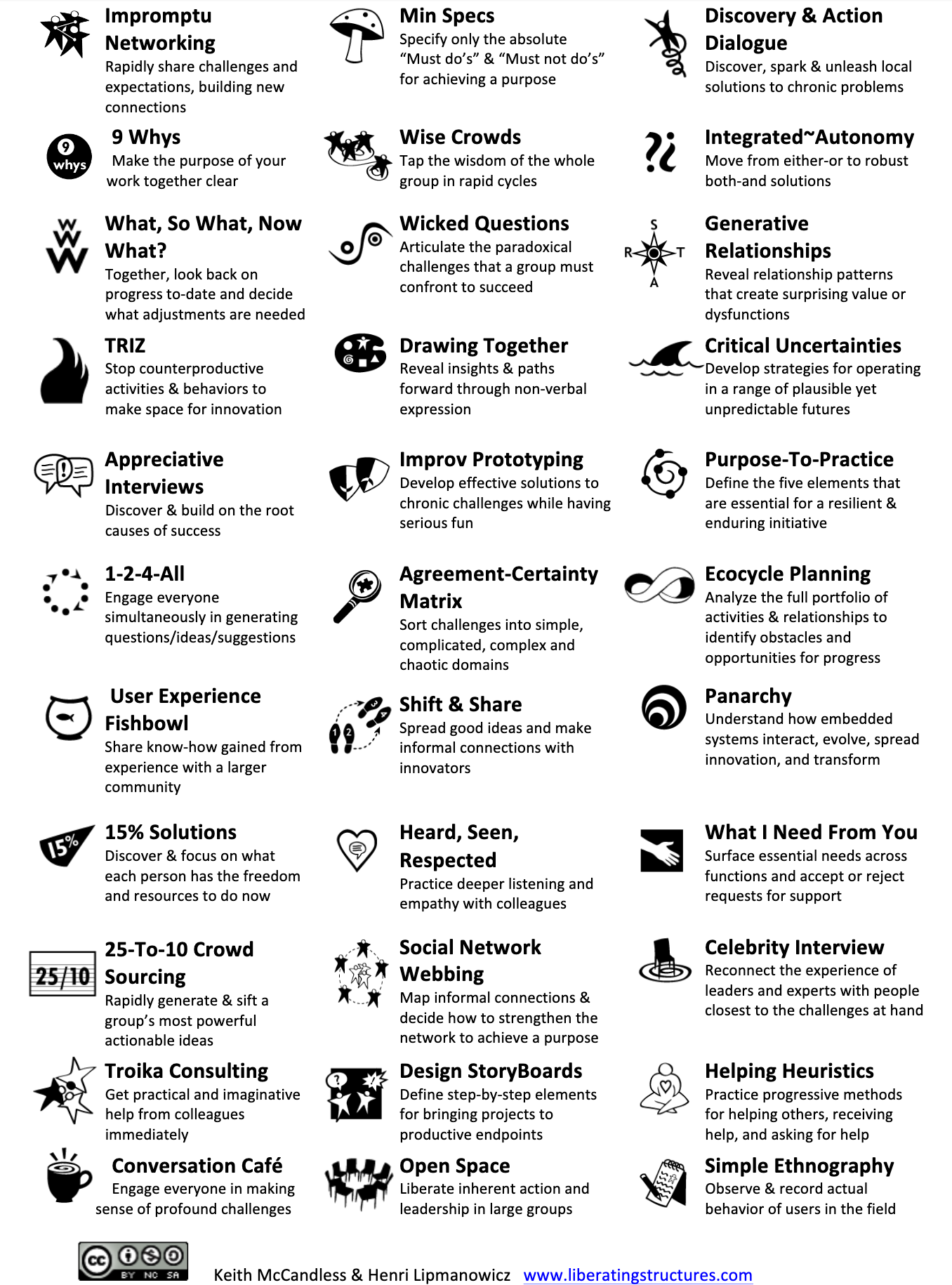Experiences using liberating structures
Liberating structures promise to unleash innovation, creativity and great ideas. Here I capture my thoughts and feelings, from my experiences with liberating microstructures.
As part of this post I will include a brief overview of what these microstructures are, for more information about specific structures see the liberating structure website.
What are Structures
Structures are the various parts that come together to make a workplace/enterprise. These are split into ‘Macrostructures’, ‘Microstructures’ and ‘Structural elements’.
- Macrostructures are the larger and slower moving items such as the core operating model, buildings and strategy.
- Microstructures are the smaller parts such as; meeting rooms, brainstorm and discussions. This is where and how discussions take place.
- Structural elements facilitate the microstructures. For example, whiteboards, time allocations and agendas.
All the structures play an important role, as each builds upon the other. Small changes on the lower levels over time can significantly effect the bigger structures. I have noticed for example, that virtual meetings seem to have a smaller pool of ideas and converge to a single idea much faster compared to in person meetings. Possibly, due to the fact virtual meetings only have one person speaking and it can be difficult to edge in. This reduces the pool of ideas and the best idea may not be chosen.
It’s important to note that each level of the structures listed above include both tangible and intangible elements. Liberating structures are specifically different ways to have a meeting/discussion/report. This puts them in the category of intangible microstructures.
Conventional Structures
There are five main conventional structures that people use:
- Presentations
- Status Reports
- Managed Discussions
- Open Discussions
- Brainstorms
These are the most common options for information sharing, but they aren’t without their problems. The first three structures are inhibiting as they don’t allow everyone to get involved and often restrict the majority of the talking to a small amount of people. On the other hand, the final two are often too loose and disorganised to drive actual outcomes.
However, these problems can be solved through the use of liberating structures.
Liberating Structures
Liberating structures are 33 alternatives to the conventional structures noted above. They aim to structure your meeting to get everyone involved whilst not inhibiting anyone.
Each structure has its own different use cases and they often have different outcomes, so picking the right tool for the job is important. Many of them leverage the ‘1-2-4-All’ structure, where you think alone, in pairs and in quads before then sharing with the rest of the group.
 List of the structures taken from - Liberating Structures
List of the structures taken from - Liberating Structures
The Experiences
This post will be updated as I use more of the structures, and if my views of the structures significantly change as I have more experince with them.
I have split them into two groups, one when I facilitated the meeting and another when I was a participant.
Contents
Facilitator
Acted as Facilitator
- Wicked Questions - Used to find the opposing strategies that both need to be pursued to be successful.
I enjoyed using this structure and I think the team enjoyed the task as they had not tried anything similar before.
The rules for this structure were easy to follow and not overly perscriptive in it's method.
It was good to put down in words, some of these paradoxical challenges the team faces, even though some of them are obvious to many members of the team. None of the generated questions particually stuck out, as ground breaking. A couple being a little one sided - but overall it was a good mix.
I found it difficult to bulid upon the the wicked questions proposed back to the entire group, however, we came together to find an overall wicked question that covered the major aspects of other questions that were proposed.
Once the questions were listed, I felt the group didn't really know how to proceed, as we had identified problems without obvious solutions. As by the very nature of wicked questions they are not easily fixable. It will be interesting to see if over time this leads the team to reduce the friction between the two sides of the major dichotomy.
I would recommend trying it out with your team.
- Impromptu Networking - Focusing on people and the power of loose connections.
Coming soon (25-01-2021)
- What, So What, Now What? - Reflecting on progress and making adjustments.
Coming soon (25-01-2021)
Acted as Participant
More Coming Soon.